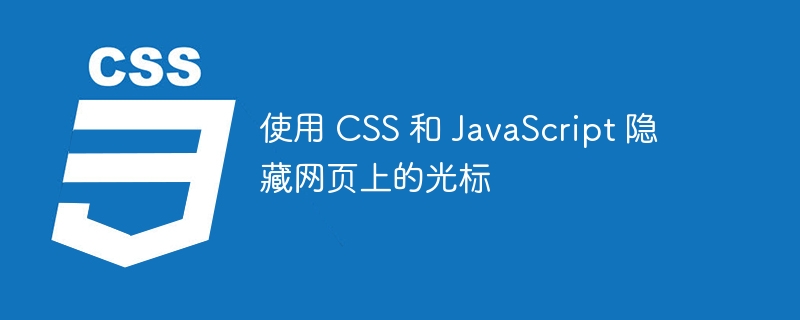Home >Web Front-end >CSS Tutorial >Hide the cursor on web pages using CSS and JavaScript
Hide the cursor on web pages using CSS and JavaScript
- PHPzforward
- 2023-09-17 19:53:031072browse

In this tutorial, we will learn to hide the cursor in a web page using CSS and JavaScript. Sometimes, we need to create a styled cursor and then need to hide the cursor. Maybe it's also necessary to hide the cursor for specific HTML elements.
There are two ways to hide the cursor on a web page. One uses CSS and the other uses JavaScript. We will learn both methods one by one in this tutorial.
Use CSS to hide the cursor on a web page
CSS Allows us to change the style of the cursor. We can create different types of cursors using CSS. If we don't want to show the cursor, we can apply the style "cursor: none" to a specific HTML element.
grammar
Users can hide the cursor using CSS according to the following syntax.
CSS Selector {
cursor: none;
}
Example
In this example, we created the div element and specified the correct height and width. Additionally, we apply a red background color to the div using CSS. After that, we add the class attribute to the div element and initialize it with the "test" value.
We use the test class name as a CSS selector in CSS and apply the "cursor: none" style to the div element.
<html>
<head>
<style>
.test {
/* style to hide the cursor */
cursor: none;
height: 300px;
width: 300px;
background-color: red;
}
</style>
</head>
<body>
<h2>
Hiding the cursor using <i> CSS. </i>
</h2>
<!-- hiding the cursor in this div element -->
<div class="test">Hiding the cursor for this div.</div>
</body>
</html>
In the above output, the user can observe that the cursor disappears when the user moves the cursor into the div element.
Use JavaScript to hide the cursor on web pages
We can use JavaScript to change the style of any HTML element. Each HTML element contains a style attribute, which we can access by passing the HTML element as a reference. Afterwards, we can access the specific style property of the style attribute and change its value. Here we will use JavaScript to change the value of the cursor attribute to none.
grammar
Users can use JavaScript to hide the cursor on a web page according to the following syntax.
let testDiv = document.getElementById("test");
testDiv.style.cursor = "none";
In the above syntax, style is the attribute of the testDiv element, and the cursor is the attribute of the style object. We change the value of the cursor property to "none".
Example
In the example below, we access the HTML div element via the id in the <script> tag. After that, we have to change the cursor property value of its style object to "none" to hide the cursor in that particular div element. </script>
<html>
<head>
<style>
.test {
height: 300px;
width: 300px;
background-color: blue;
}
</style>
</head>
<body>
<h2>Hiding the cursor using <i>JavaScript.</i></h2>
<div class="test" id="test">Hiding the cursor for this div.</div>
</br>
<button onClick="HideCursor()">Hide cursor on Div</button>
<script>
// Accessing the HTML element by id
let testDiv = document.getElementById("test");
function HideCursor() {
// hiding the cursor
testDiv.style.cursor = "none";
}
</script>
</body>
</html>
In the above output, when the user clicks the "Hide Cursor on Div" button, it hides the cursor on the div element.
We learned two ways to hide the cursor on specific HTML elements on a web page. Users can use one of these methods depending on whether they want to change the cursor style from CSS or JavaScript.
The above is the detailed content of Hide the cursor on web pages using CSS and JavaScript. For more information, please follow other related articles on the PHP Chinese website!

